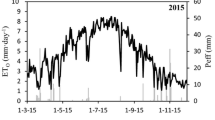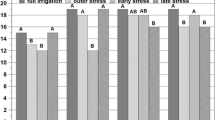Abstract
The impacts of three different water stress-timing patterns for three levels of seasonal applied water on production were evaluated in mature almond trees [Prunus dulcis (Mill.) Webb cv. Nonpareil] grown under high-evaporative demand conditions in the southern San Joaquin Valley of California. The stress timing patterns involved biasing water deficits to the pre-harvest or post-harvest periods in addition to uniform deficit irrigation for the entire season, referred to as A–C patterns. The three levels of water availability were 55, 70, and 85% of potential seasonal evapotranspiration (ETc) equivalent to 580, 720, and 860 mm of applied water per season, respectively. Treatments were imposed over four seasons. Predawn leaf water potential was used as the stress indicator and approached −4.0 MPa with the A pattern at the lowest applied water level and −3.5 MPa with the B pattern at the same irrigation level. For every level of applied water, kernel weight at harvest was significantly reduced in the A pattern relative to the B and C patterns. At harvest, the most severe reduction in kernel dry weight relative to the control (17%) occurred in 580A, while there were 11% reductions in 580B and 580C. At the 860 mm level, only the A pattern dry kernel weight was less than the control. Moreover, the A patterns for all irrigation levels had lower kernel percentages than for the B and C patterns, indicating the greater sensitivity of kernel growth relative to shell growth in the regulated deficit irrigation (RDI) scenarios that biased the stress toward pre-harvest. The B stress patterns had a strong negative impact on fruit load relative to the A patterns at the 580 and 720 mm levels of applied water. No differences in crop load relative to the control were observed among the A and C regimes for all three levels of applied water. Nut load tended to increase during the experiment with 580A and 720A while it decreased with time with the B patterns for the same irrigation levels. We believe that the lower fruit loads involve stress during flower bud differentiation, which occurs mid-August–September in this cultivar and location, quite late in the season relative to other fruit and nut crops. The most successful stress timing pattern in terms of yield (the integrator of fruit size and load) was C, which avoided the large swings in tree stress observed with A and B. The onset of hull splitting was delayed by the severe pre-harvest stress in 580A while being accelerated by the milder stress of 720A. Spider mite levels were unaffected by the RDI. Canopy size was reduced with the A patterns at all irrigation levels. This occurred without any concomitant reduction in fruit load, resulting in higher fruiting densities (305 and 283 nuts/m2 of orchard floor shaded area in 580A and 720A, respectively, vs. 214 nuts/m2 in the control). Coupling the higher fruiting densities and smaller canopy sizes with higher tree planting densities offers growers the possibility of increasing yields while consuming less water. Maintaining more compact canopies with RDI rather than pruning would also lessen the amount of wood requiring disposal, thereby moderating air quality degradation resulting from burning. It must be emphasized that the scenario we outline—increasing kernel yields while using less water due to stress-related higher fruiting densities—requires that the smaller canopies be maintained by RDI, not pruning.





Similar content being viewed by others
References
Almond Board of California (2002) Almond almanac. The almond board of California, 1150 Ninth St., Suite 1500, Modesto, CA 95354, USA
Castel JR, Fereres E (1982) Responses of young almond trees to two drought periods in the field. J Hortic Sci 57(2):175–187
Castro JS, Jimenez P (2002) Vigor and yield evaluation in almond trees under two pruning treatments. Acta Hortic 591:515–517
Edstrom J, Krueger B (2000) Pruning trials for high density orchards. University of California Nickels Soil Laboratory Annual Report, Colusa, CA, pp 26–29
Esparza G, DeJong TM, Weinbaum SA, Klein I (2001) Effects of irrigation deprivation during the harvest period on yield determinants in mature almond trees. Tree Physiol 21:1073–1079
Fereres E, Goldhamer DA (1990) Deciduous fruit and nut trees. In: Stewart BA, Nielsen DR (eds) Irrigation of agricultural crops Mon.#30. American Society of Agronomy, Madison WI, pp 987–1017
Girona J, Marsal J, Cohen M, Mata M, Miravete C (1993) Physiological growth and yield responses of almond (Prunus dulcis L.) to different irrigation regimes. Acta Hortic 335:389–398
Goldhamer DA, Smith T (1995) Single season drought irrigation strategies influence almond production. Calif Agric 49(1):19–22
Goldhamer DA, Viveros M (2000) Effects of preharvest irrigation cutoff durations and postharvest water deprivation on almond tree performance. Irrig Sci 19:125–131
Hsiao TC (1973) Plant responses to water stress. Annu Rev Plant Physiol 24:519–570
Hsiao TC (1990) Measurements of plant water status. In: Stewart BA, Nielsen DR (eds) Irrigation of agricultural crops mon#30. American Society of Agronomy, Madison, WI, pp 243–279
Hutmacher RB, Nightingale HI, Rolston DE, Biggar JW, Dale F, Vail SS, Peters D (1994) Growth and yield responses of almond (Prunus amygdalus) to trickle irrigation. Irrig Sci 14:117–126
Jerie PH, van den Ende B, Dann IR (1989) Managing tree vigor and fruitfulness in deciduous orchards. Acta Hort 240:127–134
Klein I, Esparza G, Weinbaum SA, DeJong TM (2001) Effects of irrigation deprivation during the harvest period on leaf persistence and function in mature almond trees. Tree Physiol 21:1063–1072
Lamp BM, Connell JH, Duncan RA, Viveros M, Polito VS (2001) Almond flower development: floral initiation and organogenesis. J Am Soc Hort Sci 126(6):698–696
Moriana A, Orgaz F, Pastor M, Fereres E (2003) Yield responses of mature olive orchard to water deficits. J Am Soc Hort Sci 123(3):425–431
Nanos GD, Kazantzis I, KefalasP, Petrakis C, Stavroulakis GG (2002) Irrigation and harvest time affect almond kernel quality and composition. Scientia Hort 96:249–256
Orgaz F, Mateos L, Fereres E (1992) Season length and cultivar determine the optimum evapotranspiration deficit in cotton. Agron J 84(4):700–706
Prichard TL, Asai W, Verdegaal P, Micke PW, Teviotdale B (1993) Effects of water supply and irrigation strategies on almonds. In: Proceedings of 21st almond research conference. The almond board of California, 1150 Ninth St., Suite 1500, Modesto, CA, pp 29–35
Shackel K (2002) Deficit irrigation management during hull-split. In: Proceeding of the 30th almond research conference. The almond board of California, 1150 Ninth St., Suite 1500, Modesto, CA, pp71–75
Snyder RL, Pruitt WO (1989a) Reference evapotranspiration. In: Goldhamer DA, Snyder RL (eds) Irrigation scheduling: a guide for efficient on-farm water management. Univ of Calif, Div Agic Nat Res Pub 21454:24–27
Snyder RL, Pruitt WO (1989b) Crop coefficients. In: Goldhamer DA, Snyder RL (eds) Irrigation scheduling: a guide for efficient on-farm water management. Univ Calif, Div Agric Nat Res Pub 21454:30–32
State of California, Department of Water Resources (1998) The California water plan update Bulletin vol 1. Sacramento, CA, pp 160–198
Teviotdale BL, Goldhamer DA, Viveros M (2001) Effects of deficit irrigation on hull rot disease of almond trees caused by Monilinia fructicola and Rhizopus stolonifer. Plant Dis 85(4):399–403
Torrecillas A, Ruiz-Sanchez MC, Del Amor F, Leon A (1989) The response of young almond trees to different drip-irrigated conditions. Development and yield. J Hort Sci 64:1–7
Torrecillas A, Alarcon JJ, Domingo R, Planes J, Sanchez-Blanco MJ (1996) Strategies for drought resistance in leaves of two almond cultivars. Plant Sci 118:135–143
Tufts WP, Morrow EB (1925) Fruit-bud differentiation in deciduous fruits. Hilgardia. Calif Agri Exp Sta 1(1)
United States Department of Agriculture (2004) Preliminary summary: noncitrus fruit and nuts. National Agricultural Statistics Service, Fairfax, VA, p 7
Uriu K (1964) Effect of post-harvest soil moisture depletion on subsequent yield of apricots. J Am Soc Hort Sci 84:93–97
Uriu K, Martin PE, Hagan RM (1970) Radial trunk growth of almonds as affected by soil water and crop density. J Am Soc Hort Sci 95(2):166–169
Youngman RR, Barnes MM (1986) Interaction of spider mites (Acari: Tetranychidae) and water stress on gas-exchange rates and water potential of almond leaves. Environ Entomol 15:594–600
Zalom FG, Bentley WJ (1986) Southern fire ant (hymenoptera: Formicidae) damage to harvested almonds in California. J Econ Entomol 78(2):339–341
Acknowledgments
The authors wish to thank the management and staff of Paramount Farming Co. Inc., for their cooperation in providing the experimental site as well as commercial hulling, processing, and nut quality analysis. In particular, we thank Joe McIlvaine, Don Castle, Hung Le, Joe Gonzales, and Rob Baker. We also appreciate the technical assistance of our field technicians Jesus Salinas, Cindy Green, Miguel Marquez, Juan Gomez, Dan Howes, Don Katayama, Scott Fusi, and Peggy Schrader. We gratefully acknowledge the support of our colleagues Elias Fereres, for his valuable editorial input, and Walt Bentley, for the mite monitoring. This work was funded by a grant from the California Almond Board.
Author information
Authors and Affiliations
Corresponding author
Additional information
Communicated by E. Fereres
Rights and permissions
About this article
Cite this article
Goldhamer, D.A., Viveros, M. & Salinas, M. Regulated deficit irrigation in almonds: effects of variations in applied water and stress timing on yield and yield components. Irrig Sci 24, 101–114 (2006). https://doi.org/10.1007/s00271-005-0014-8
Published:
Issue Date:
DOI: https://doi.org/10.1007/s00271-005-0014-8




